Gloria! Feature Review VIFF2024-19

At its heart, Gloria! is a feel-good film. Strip away its 19th-century Venetian orphanage setting, and what remains is a familiar narrative: a group of teenagers uniting to overcome a corrupt system, a tyrannical leader, a male-dominated environment, and personal obstacles. Along the way, they discover their voices (one quite literally), gain creative and personal freedom, and even find love.
What sets Gloria! apart is its basis in truth. In Venice at the time, orphanages often doubled as conservatories, where young women were taught music, singing, and instrumental performance, often in churches. This practice continued until Napoleon’s 1807 edict brought it to an end.
Though grounded in historical fact, Gloria! is far from a typical period drama. It is, above all, a celebration of music—the love of it, its transformative power, and its ability to break barriers.
At the center of the film are two young women: Lucia, a charismatic and highly talented violinist and composer, and Teresa, a mute servant from the lowest ranks, mistreated by the convent’s music maestro. When a famous piano maker, impressed by the girls’ talents, donates a piano, the maestro hides it. However, Teresa discovers it, and soon the other girls follow, sparking a musical duel between Lucia’s baroque classical training and Teresa’s untrained, jazz-pop rhythms.
As the Pope’s visit approaches, the plot thickens. The maestro, preoccupied with covering his lover/protégé’s gambling debts, fails to compose a new piece. Lucia’s heart is broken, Teresa finds her voice, and the convent’s dark secrets are exposed.
The film culminates in a modern, jubilant celebration of music, dance, and freedom. The old, conservative, male-dominated world is left in shock, while the young—those who supported the girls, the children, and the newly liberated women—join in the joyful festivities.
Gloria! has its flaws. Sometimes it leans on narrative clichés and the timeline is unclear. However, these shortcomings don’t detract from the film’s beautiful and powerful performances by the cast. It is hard not to get drawn into the group and be taken by their friendship and love of music. The film is well-executed, both in cinematography and editing, while the art direction is easily inspired by the art of the time. Above all, it’s harmonious blending of baroque music (with nods to Vivaldi, once a maestro at the original convents) with pop and electronic sounds turn into one grand musical celebration. We left the cinema, and everyone was moving.
It’s clear that the filmmaker loves music—and, as it turns out, is a musician herself.
Share This:
Recent Posts
- THIS ENTRY WAS POSTED IN: VIFF2024 Reviews



